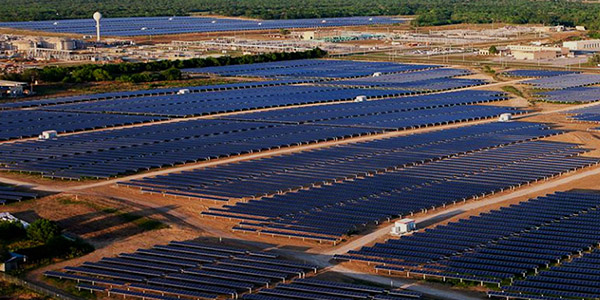With almost 31 GW of wind capacity, Texas can lay claim to having more wind resources than any other state and all but four countries.
ERCOT, which manages about 90% of the Texas grid, has almost 25 GW of that capacity. It expects to have 38 GW of wind capacity by 2023.
Blessed with wide open spaces, a friendly business environment and one of the world’s most efficient deregulated energy markets, the Lone Star State is also on track to stake out similar leadership in solar energy.
In November, Invenergy announced it was building what will be the largest U.S. solar farm in northeastern Texas. The 1.31 GW Samson Solar Energy Center, within ERCOT’s footprint near its seam with SPP, will be built in five phases over the next three years through a $1.6 billion investment.
ERCOT began 2020 with 2.28 GW of solar capacity, but projects that number to quintuple to 12.31 GW by the summer of 2022.
“We have giant solar resources here. The demand has never been better,” Charlie Hemmeline, executive director of the Texas Solar Power Association (TSPA), said during a webinar in November. “We’re definitely looking forward to adding megawatts.”
Solar energy has several advantages. The TSPA says expanded and more efficient manufacturing, advanced technology, economies of scale, and sophisticated financing partners have resulted in cost-competitive prices. According to the financial advisory firm Lazard, solar’s electricity costs have fallen by 89% in the last decade.
Solar facilities can also be built closer to load centers, forgoing the need for expensive transmission infrastructure often necessary to connect wind facilities to the grid.
‘Good Fundamentals’

Hemmeline said the key has been the ERCOT market and its prices, among the 10 cheapest states as recently as October ($.083/KWh).
“The market structure has worked very well for solar,” he said. “Texas has a lot of good fundamentals and characteristics. You’ve got a highly competitive generation market and on the other side, a highly competitive retail market. Our solar resources are fantastic, but a lot of other states have good solar resources and higher electricity prices.”
ERCOT’s long-term system assessment projects “significant” growth in solar and wind resources over the next 10 to 15 years across five different future scenarios. Here significant means more than doubling solar generation capacity by 22.2 GW to 35.3 GW and more than doubling wind capacity by 35 GW to 44.8 GW.
The assessment also foresees more than 21 GW of existing coal and natural gas generation capacity to be retired by 2035. Wind has already surpassed coal as the No. 2 fuel in ERCOT, behind only gas resources.
“There are a lot of changes in the resource mix,” ERCOT CEO Bill Magness told the Board of Directors in December. “We’ve started to see, as expected, real impacts of utility-scale solar.”
The projected influx of wind and solar energy — and now battery storage — has raised ERCOT’s planning reserve margins to healthy percentages in the mid-20s through 2025, double the ISO’s minimum target of 13.75%. Gone are the days of single-digit reserve margins and sweaty palms in the face of record demand during the dog days of summer.
Magness said ERCOT had three major overarching goals in 2020: establishing rules for batteries and other new resources, improving the exchange of data information with the market and strengthening its core systems.
Much of that work is now part of the grid operator’s Passport Program, which is designed to allow emerging technologies to expand their participation in the market. Staff and stakeholders will spend the next four years aligning the task forces’ work with an upgrade of the grid operator’s energy management system that also incorporates distribution generation resources into its systems. (See ERCOT Board of Directors Briefs: Dec. 8, 2020.)
“We’re in a good position to start taking on work in 2021,” Magness said.
New Tx Needed
ERCOT also has staff’s eyes on the transmission system. The ISO endorsed almost $600 million in transmission projects in 2020, including the $219 million Corpus Christi North Shore Project to address future industrial load growth on the lower Gulf Coast. (See “Corpus Christi Tx Project Gets OK,” ERCOT Board of Directors Briefs: June 9, 2020.)
Some stakeholders have warned more transmission will be necessary to stay ahead of the renewable tsunami. Texas’ Competitive Renewable Energy Zones effort jump-started the growth of West Texas wind energy, but that was almost a decade ago. Oil and gas activity in the Permian Basin has only exacerbated the situation.
“We’re finding in our region that the transmission is getting loaded up now,” said David Hudson, president of Xcel Energy’s Southwestern Public Service subsidiary.
“[Renewable] generation is developing faster than transmission in ERCOT. We need more transmission to relieve the congestion,” said Susan Williams Sloan, the American Wind Energy Association’s vice president of state affairs. “The current system we have is not really fixing the problem. One of the things we need to do is talk about the fact that 20 years ago, when the competitive market was set up, [state] leaders understand transmission was [then] fundamental to the market.”
Help is coming. ERCOT’s 2020 Regional Transmission Plan lists eight noteworthy reliability projects and three economic projects that will be necessary by 2027. The Regional Planning Group said transmission owners will provide the ISO additional details on projects under review “to ensure the identified system facilities are still needed.”
If Texas is going to continue to grow “in the way that we know it can,” Hudson said, “transmission will be an important part in that — and figuring out the right way to build and allow the growth of the Texas energy market.”






